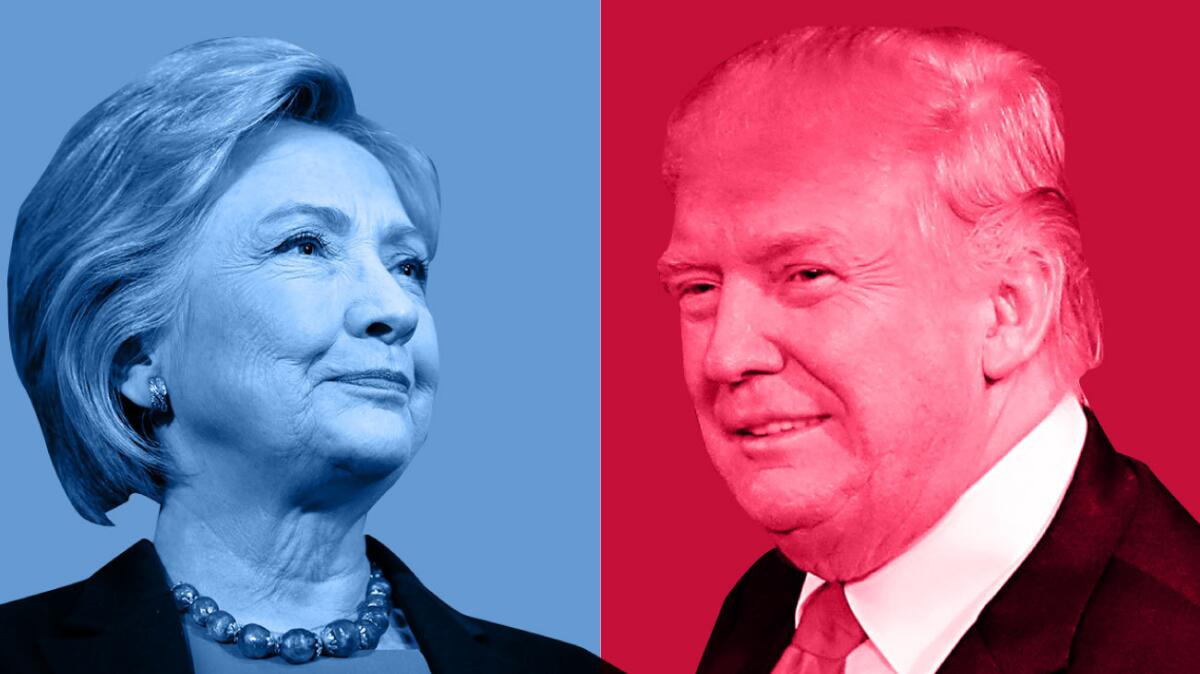Why the USC/L.A. Times tracking poll differs from other surveys

- Share via
Reporting from Washington — Since July 28, when Hillary Clinton accepted the Democratic nomination, she has gained five points in the USC Dornsife/LA Times Daybreak tracking poll of the election. That’s similar to Clinton’s gain in other measures of the race, including the 538.com polling forecast (4.5-point gain) and the Real Clear Politics average (2.9-point gain).
But although the trend lines are similar, the Daybreak tracking poll shows a smaller lead for Clinton. As of today, the tracking poll shows Clinton leading by two percentage points, 45% to 43%, compared with a nine-point lead in the Huffington Post polling average (48% to 39%), an eight-point lead in the Real Clear Politics average (48% to 40%) and a seven-point lead in 538.com’s model of national polls (45% to 38%).
Why the difference? Part of the answer is simply statistical noise — all these differences are within the polls’ margins of error. But another part involves the post-convention bounce that Clinton has been enjoying.
Typically, candidates get a boost after their conventions, and typically that increase fades pretty quickly. The Daybreak poll is built in a way that mutes the impact of bounces and temporary shifts in candidate support.
If Clinton’s current high level is sustained, she’ll continue to move up in the Daybreak poll, as she has been doing for a week and a half. If her post-convention increase turns out to be a bounce that fades at least partially, the polling averages will show the race tightening.
Either way, the current gap between the tracking poll and the other measures of the election likely will shrink over the next couple of weeks.
That probably won’t close the whole gap, though. A couple of other aspects of the Daybreak poll make it differ from most other surveys:
Typically, polls ask people which candidate they favor or lean toward. Those who say they don’t know or are undecided don’t get factored into calculations of candidate support.
The Daybreak poll, by contrast, asks voters, using a 0-to-100 scale, to rate their chances of voting for Clinton, for Trump or for some other candidate. As a result, everyone who responds to the survey has some impact on the results. Because that approach gathers information from everyone in the poll sample, it should give a better read on the many voters who remain ambivalent about their choices.
See the most-read stories this hour >>
Using the 0-to-100 scale, however, almost certainly makes the Daybreak poll differ somewhat from other surveys. As with the bounce, any difference that results should shrink as election day gets closer and voters become more certain of their choices.
Finally, some analysts think the Daybreak poll is slightly tilted toward the Republican side because of how it accounts for the way people voted in the last election.
All pollsters weight their results somewhat to make sure their samples match known demographics — the right proportions of men and women, for example, or blacks, whites and Latinos.
The Daybreak poll goes a step further and weights the sample to account for how people say they voted in 2012: It’s set so that 25% of the sample are voters who say they cast a ballot for Mitt Romney and 27% for President Obama. The rest are either too young to have voted four years ago or say they didn’t vote.
The potential problem is that people tend to fib about how they voted. Polls have often found that the percentage of people who say after an election that they voted for the winner exceeds the winner’s actual vote.
If that’s the case this year, then weighting for the vote history would result in slightly too many Republican voters in the sample, which would probably boost Trump’s standing by a point or two.
Unfortunately, there’s no way to know for sure until we can compare the final vote to the poll’s final forecast. Given how long it takes to count all the votes, that answer won’t be available until at least a week after election day.
For more on Politics and Policy, follow me @DavidLauter
ALSO
USC Dornsife / Los Angeles Times tracking poll: Where does the race stand today?
Trail Guide: Live updates from the campaign trail and beyond
More to Read
Get the L.A. Times Politics newsletter
Deeply reported insights into legislation, politics and policy from Sacramento, Washington and beyond. In your inbox twice per week.
You may occasionally receive promotional content from the Los Angeles Times.











